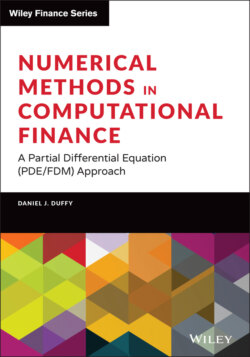Читать книгу Numerical Methods in Computational Finance - Daniel J. Duffy - Страница 37
2.2.2 Rationale and Generalisations
ОглавлениеThe IVP Equation (2.1) is a model for all the linear time-dependent differential equations that we encounter in this book. We no longer think in terms of scalar problems in which the functions in Equation (2.1) are scalar-valued, but we can view an ODE at different levels of abstraction. To this end, we focus on the generic homogeneous ODE with solution :
(2.4)
This equation subsumes several special cases:
1 The variable is a square matrix, and then Equation (2.4) represents a system of ODEs. This is a very important area of research having many applications in science, engineering, and finance.
2 The variable is an ordinary or partial differential operator, and then Equation (2.4) represents an ODE in a Hilbert or Banach space.
3 The variable is a tridiagonal or block tridiagonal matrix that originates from a semi-discretisation in space of a time-dependent partial differential equation (PDE) using the Method of Lines (MOL) as discussed in Chapter 20.
4 The formal solution of (2.4) is:(2.5) In other words, we express the solution in terms of the exponential function of a matrix or of a differential operator. In the former case, there are many ways to compute the exponential of a matrix (see Moler and Van Loan (2003)).
5 The solution of Equation (2.4) can be simplified by matrix or operator splitting of the operator :(2.6) For example, we can split a matrix into two simpler matrices, or we can split an operator into its convection and diffusion components. In other words, we solve Equation (2.4) as a sequence of simpler problems in (2.6). These topics will be discussed in Chapters 18, 22, and 23.
6 The initial value problem (2.1) was originally used as a model test of finite difference methods in (Dahlquist (1956)). The resulting results and insights are helpful when dealing more complex IVPs.
Finally, this chapter and Chapter 3 are recommended for readers who may not be familiar with ODE theory and ODE numerics. It is a prerequisite before moving to partial differential equations.
